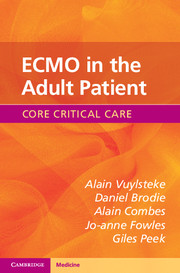Introduction
Veno-arterial ECMO allows gas exchange and pumps blood from a vein to an artery. It is used to support failing lungs and can be used to support a failing heart.
Veno-arterial ECMO allows stabilization of the patient by perfusing vital organs with oxygenated blood. During veno-arterial ECMO, both the ECMO and the heart pump blood around the patient’s body.
If no gas is flowing through the oxygenator, deoxygenated venous blood will be pumped into the arterial circulation, creating a veno-arterial shunt.
Veno-arterial ECMO will be continued until the clinical team has decided the best treatment for a specific patient. Two circulations having to work in parallel renders the management of the patient on veno-arterial ECMO much more complex than veno-venous ECMO. Patients may rapidly develop complications.
Patients supported with veno-arterial ECMO frequently have other organ failure and require a high level of critical care support. The day-to-day management of patients on veno-arterial ECMO is the same as for all critically ill patients, plus some specific elements. This chapter describes these specific elements.
Locally agreed protocols for the care of ECMO patients should be incorporated into training.
Monitoring of the patient on veno-arterial ECMO has been described in Chapter 4.
Stabilization on veno-arterial ECMO
Insertion of ECMO cannulas should ideally take place in an operating room. A variety of configurations can be used.
Peripheral cannulation can be achieved percutaneously and does not require surgery. Central and direct cannulation require surgery.
It can be striking how rapidly pharmacological support can be modified after veno-arterial ECMO support has been started. Inotropes and other vasoactive drugs can often be decreased.
It is essential to ensure that the heart continues to eject to avoid thrombosis in the cardiac cavities. Maintaining pulmonary blood flow may also prevent the formation of intrapulmonary thrombi. The absence of ventricular ejection will lead to cardiac distension and prevent possible cardiac recovery.
Lung ventilation can be adapted immediately after veno-arterial ECMO has been established. Similar principles of applying the least-damaging ventilation, as in veno-venous ECMO, should be applied (see Chapter 8). It is essential to ensure that the lungs still provide gas exchange, as the blood going through the lungs will need to be oxygenated (and CO2 removed) to avoid a hypoxic mixture being delivered to some tissues (e.g. the coronary arteries). Changes in mechanical ventilation can affect the venous return and modify both cardiac output and ECMO flow.
After stabilization, the patient can undergo multiple non-invasive tests to determine the cause and decide subsequent management.
Oxygenation during veno-arterial ECMO
During veno-arterial ECMO support, O2-saturated blood from the ECMO circuit enters the arterial circulation.
The PaO2 in the arterial system at the point of entry is similar to that after the oxygenator, and it is therefore essential to adjust the O2 concentration of the sweep gas going through the oxygenator.
The blood returning from the ECMO circuit will mix with any blood pumped by the heart. This will occur in the ascending aorta when central veno-arterial ECMO is used, or in any location if the ECMO blood is returned in a peripheral artery. There will be different concentrations of O2 in different tissues. Arterial blood gases are ideally obtained from the right radial artery, as this will be the furthest accessible point of arterial blood when the ECMO blood is returned in the femoral artery.
Systemic arterial oxygenation is determined by the relative contributions of the native and ECMO circulation, ECMO blood flow, deoxygenated venous return, the degree of pulmonary dysfunction, O2 consumption and oxygenator efficiency.
Adjuncts to veno-arterial ECMO
Leg reperfusion
In the case of peripheral ECMO, insertion of a reperfusion line is indispensable; this is described in Chapter 6.
Fluid balance
Removing excess water optimizes lung mechanics and pulmonary gas exchange but should be balanced against the need to keep the heart ejecting without excess distension.
Tracheostomy
Tracheostomy, either percutaneous or surgical, may be performed to provide a more secure airway, facilitate a reduction in sedation, improve comfort and ultimately aid weaning from ventilation.
However, tracheostomy increases the risk of major haemorrhage, and this should be assessed in each patient. Early tracheostomy has not been shown to be associated with increased survival.
It is often possible, and arguably preferable, to wake and extubate patients supported with veno-arterial ECMO.
Inotropes
Inotropes will be used to ensure the heart continues to eject. There is no evidence that continued use of inotropes facilitates recovery.
Intra-aortic balloon pump
An intra-aortic balloon pump may have been in place before the initiation of veno-arterial ECMO and continued afterwards. It may be inserted after initiation of veno-arterial ECMO to facilitate cardiac ejection.
Ventricular vents
The surgical insertion of ventricular vents might be required in the case of very poor remaining cardiac function with no ejection. This will prevent overdistension of the cardiac chambers and blood stasis with formation of thrombi. Blood will drain directly into the drainage side of the ECMO circuit. Extra cannulas increase the risk of disconnection or cannula displacement.
Another solution to a non-ejecting heart is to switch from peripheral veno-arterial ECMO to a central configuration. The direction of central veno-arterial ECMO blood flow does not increase the afterload and surgical vents can be inserted under direct vision.
Key points
Management of the patient on veno-arterial ECMO is highly complex.
Veno-arterial ECMO is only temporary and is used as a bridge to another solution or recovery.



